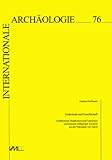
Grabritual und Gesellschaft in Unteritalien während des 4. Jh. v.Chr.: Gefäßformen, Bildthemen und Funktion unteritalisch-rotfiguriger Keramik aus der Nekropole von TarentAndreas Hoffmann
Taschenbuch
Traditionell wurde die unteritalisch-rotfigurige Keramik des 5.-3. Jh. v.Chr. fast ohne Berücksichtigung der antiken Verwendungskontexte betrachtet. Mit repräsentativen 549 von rund 1.300 Grabfunden aus Tarent wird erstmals ein großer Materialkomplex aus einem der Hauptproduktionsorte der Keramik vorgelegt. Zudem erlaubt die überwiegend geübte Körperbestattung in Einzelgräbern die Bestimmung von Geschlecht, Alter und Beigabenausstattung der Individuen. Mit Hilfe der Korrespondenzanalyse werden die Typen chronologisch geordnet und durch Münzbeigaben absolut datiert. Darauf aufbauend lassen sich die einzelnen Phasen des Grabrituals beschreiben und die sozialen und ideologischen Dimensionen des Grabrituals untersuchen. Es folgt eine Diskussion des tarentinischen Bildrepertoires, das hier in all seiner „Durchschnittlichkeit“ ohne Selektion durch den Kunsthandel greifbar wird, hinsichtlich der Beziehungen von Gefäßform und Bild, des Verwendungsspektrums, des Geschlechtes der Bestatteten und des zeitlichen Wandels. Ein historischer Überblick setzt die Topographie der Nekropole und das Grabritual in Bezug zur Ereignisgeschichte Tarents. Traditionally, the Lower Italian red figured pottery of the 5th to 3rd century B.C. has been discussed mainly without consideration of its antique contexts of use. With representative 549 out of some 1.300 grave finds from Taranto, a large material complex from one of the main production sites of this pottery is being published for the first time. Additionally, the dominant rite of inhumation in single graves allows the determination of sex, age, and grave goods for each individual. The types are chronologically arranged by means of seriation and absolutely dated through coins in grave contexts. Based on this, the individual phases of the grave ritual are described as are the social and ideological dimensions of the burial rite. This is followed by a discussion of the picture repertoire, which becomes understandable in all its "mediocrity" without pre-selection through art commerce, with regard to the relation between vessel type and picture, the practical use, the sex of the deceased, and changes in time. A historical overview draws the connection between the topography of the necropolis and the burial ritual on the one hand and the historical events in Taranto on the other hand.
|


















